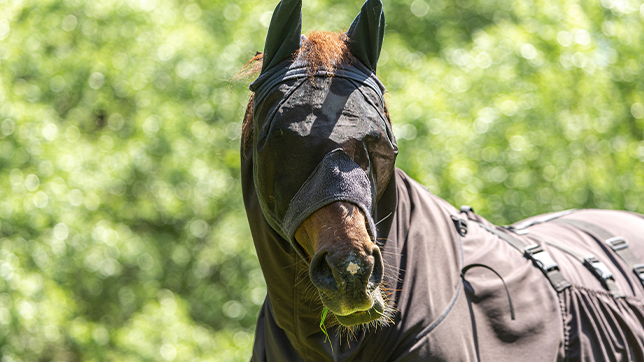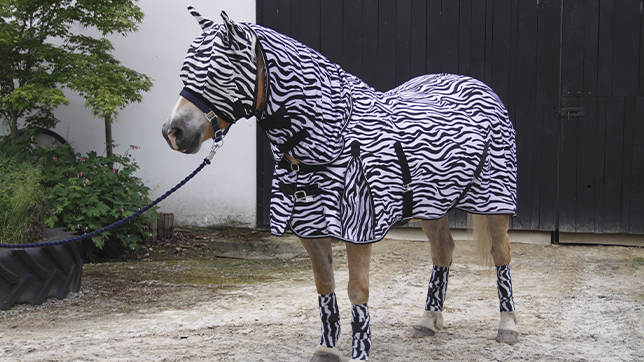22nd February 2024
Sweet itch in horses – symptoms, treatment, and prevention
For those of us with horses who have sweet itch, the spring, summer, and autumn months can feel like an uphill battle against biting flies.
We want to support you and your horse throughout the seasons, to enable you both to enjoy a happy, healthy year of adventures together – in spite of sweet itch!
What is sweet itch?
Sweet itch is a skin condition caused by an allergic reaction to the saliva of biting insects, like midges. The proteins in saliva left behind after a midge bite will trigger your horse’s immune system to respond, by becoming hypersensitive and unbearably itchy.
While there are some horses/ponies who may be at greater risk of developing sweet itch (e.g. they inherit it), the condition affects equines of all ages, breeds, and types.
Interesting fact: Sweet itch is also known as ‘Culicoides Hypersensitivity’. (Culicoides = midge species!)

Symptoms of sweet itch
Horses are individuals, just like us! So, your horse’s experience of sweet itch will be entirely different to another’s.
Although signs of sweet itch can vary in intensity from horse to horse, the most significant symptoms of sweet itch include:
- Itchiness – often to the point their skin becomes inflamed and starts bleeding.
- Crusty, broken, flaky, and/or scaly skin – which increases risk of infection.
- Hives or lumps – may appear anywhere on their body.
- Losing patches of hair from their coat – due to the excessive scratching.
- Loss of mane and tail hair – as a result of self-trauma from scratching.
- Rubbing against anything within reach – stable doors, fences, trees, etc.
- Aggressively biting at their own skin – or scratching with their hind hooves.
- Rolling repetitively – in attempt to ease severe itchiness.
- Enthusiastic mutual grooming – field friends can scratch places they can’t.
- Forceful tail swishing – to keep flies away.
- Restlessness if flies are around – and lack of concentration while ridden.
- Head-shaking – owing to the sensation of flies around their face.
- Irritated, frustrated, agitated behaviour – though lethargy is common, too.
Treatment of sweet itch
The treatment options for sweet itch will depend on the severity with which it impacts your horse’s life. Some horses may experience a mild form of sweet itch, whereas others exhibit extreme reactions to the allergic skin condition.
In all cases of sweet itch, we highly recommend discussing it with your vet, so they can help to create appropriate management plans specific to your horse’s needs.
Treatment for sweet itch won’t be able to cure the condition, though the following management methods might ease your horse’s symptoms:
- Use of soothing shampoos, lotions, and creams to calm their skin irritation.
- Cool water bathing during summer months.
- Keeping the majority of their body covered using specialist sweet itch rugs.
- Choose a stable and field that’s away from woodland areas.
- Only turn them out onto pasture that isn’t waterlogged or muddy.
- Stabling them while flies are most active (e.g. dawn and dusk).
- Vet-approved skin-friendly or immune supplements added to their daily feed.
- Antihistamines can lessen the severity of symptoms (in vet-approved doses).
- Vaccinations that relieve sweet itch symptoms (administered by your vet).
- Steroid medication (from your vet) to help control inflammation.
Remember: When treating your horse’s sweet itch, it’s essential to choose products that are vet-approved and safe for use on hypersensitive, broken, inflamed skin.
Preventing sweet itch
Unfortunately, there is no way of preventing your horse from developing sweet itch. However, as research continues to improve the quality of life for horses with sweet itch (and their owners!), we’re constantly learning more about the condition.
Here are some of the ways to ease your horse’s sweet itch symptoms:
- Keep them covered at all times (even while stabled!) with a lightweight sweet itch fly rug, as well as a fly mask offering protection for their eyes, ears, and nose.
- Consider using zebra-patterned fly protection (the stripes are believed to confuse flies and deter them from landing on your horse).
- Add a fly fringe and nose net to their bridle.
- Always dress them in a ride-on fly sheet while riding.
- Use fly sprays or fly repellent creams all over your horse (avoiding their eyes and nose!), to repel midges and other biting insects.
- Refresh their field water trough daily, to prevent stagnant water from attracting flies.
- Safely install a cold air fan (out of reach of your horse!) to keep flies away from their stable.
- Make sure your horse’s stable and field are located well away from the muck heap.
- Choose a livery yard that’s on a breezy hilltop or in a windswept coastal environment (with fields that offer plenty of shelter).

Looking for further advice about helping your horse to cope with flies this summer? Check out our article all about the fight against flies!
We're fighting for a better future
For over 20 years we have remained committed to promoting animal welfare and conservation around the world.
Looking for more horse advice?
Support and advice so that owners and riders can take the very best care of their equine.
